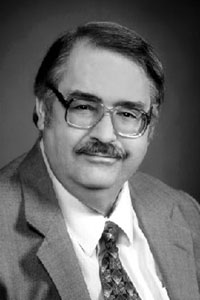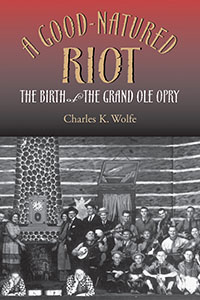In the preface to A Good-Natured Riot: The Birth of the Grand Ole Opry, author Charles K. Wolfe describes a 1973 visit to the home of Grand Ole Opry-star Herman Crook. As the sole original Opry member still performing on the show at that time, Crook represented a doorway to the program’s early history, an almost forgotten era. Over the next two decades, Wolfe had the opportunity to speak with many other surviving early cast members, and his trail of research led to his comprehensive history of the Opry’s early years, from its founding in 1925 to the program’s nationwide syndication on the NBC radio network in 1939.
 Originally published in 1999 and now available in a new paperback edition, A Good-Natured Riot traces the evolution and personalities that shaped the program, beginning with its freewheeling early days as a showcase for traditional Southern music during the height of the jazz age and moving to its role as a powerhouse driving the development of commercial country music through the 1940s and beyond.
Originally published in 1999 and now available in a new paperback edition, A Good-Natured Riot traces the evolution and personalities that shaped the program, beginning with its freewheeling early days as a showcase for traditional Southern music during the height of the jazz age and moving to its role as a powerhouse driving the development of commercial country music through the 1940s and beyond.
Although Wolfe, who passed away in 2006, was an accomplished academic, he was also a skilled and talented writer who was able to balance thorough and meticulous research with an accessible and engaging prose style. Here’s his description of the book’s subject: “The early Opry as a whole was primarily a radio show—a vague and amorphous thing born in a sparkling moment, and then vanished into the night, leaving only memories. And in the end, it was nothing but a collection of individuals and music.”
Wolfe’s ability to merge academic structure with a popular prose style results in an informative and entertaining history that doesn’t follow a strict chronological structure. Instead, Wolfe tells the story in two portions: the context of the time and place that gave birth to the Opry, and the personalities and music that sustained it through the first fourteen years of the program’s existence. He accomplishes the former in the first two chapters of the book by sketching a picture of Nashville in the mid-1920s, the music scene of Middle Tennessee during that era, and the business concerns of radio station WSM and its parent company, the Nashville-based National Life and Accident Insurance Company. Through this concise history, he explores the uneasy relationship between a Southern city that saw itself as a center of culture and education, and a successful and popular radio show that spread a “hillbilly” image of Nashville across the nation.
 Subsequent chapters offer individual portraits of many of the early Opry stars and the music and personality they brought to the program. These include such performers as Uncle Jimmy Thompson, a genuine country eccentric whose performances of old-time fiddle tunes on WSM led to the creation of the Opry, and African-American harmonica wizard DeFord Baily, who for a time was the Opry’s most popular star. Many of these early Opry acts were part-time musicians who defied stereotypes, such as Dr. Humphrey Bate, a Vanderbilt University-trained physician who led a sophisticated string band—under the influence of the Opry, these musicians found themselves performing in overalls and re-christened the “Possum Hunters.” Others had significant professional experience, such as Uncle Dave Macon, one of the most enduring of the early Opry stars, who mixed his rascally, hillbilly persona with the stage charisma he acquired as a seasoned vaudeville performer.
Subsequent chapters offer individual portraits of many of the early Opry stars and the music and personality they brought to the program. These include such performers as Uncle Jimmy Thompson, a genuine country eccentric whose performances of old-time fiddle tunes on WSM led to the creation of the Opry, and African-American harmonica wizard DeFord Baily, who for a time was the Opry’s most popular star. Many of these early Opry acts were part-time musicians who defied stereotypes, such as Dr. Humphrey Bate, a Vanderbilt University-trained physician who led a sophisticated string band—under the influence of the Opry, these musicians found themselves performing in overalls and re-christened the “Possum Hunters.” Others had significant professional experience, such as Uncle Dave Macon, one of the most enduring of the early Opry stars, who mixed his rascally, hillbilly persona with the stage charisma he acquired as a seasoned vaudeville performer.
By the mid-1930s, the Opry began its transformation into a formalized entertainment program that purposely sought out professional performers for its roster. These changes moved the program away from its roots in the folk music of Middle Tennessee while also creating its own version of “manufactured authenticity,” which incorporated western influences and musical innovations. Wolfe chronicles these changes through the arrival of such fulltime professionals as the Vagabonds, the Dixieliners, the Delmore Brothers, and Pee Wee King.
He also acknowledges the influence of the program’s behind-the-scenes management through the efforts of the program’s “creator” and early host, “Judge” George D. Hay, and its longtime general manager, Harry Stone. Although the pair frequently conflicted over business matters, both men genuinely loved the music of the Opry and sought to spread its influence to a wider audience.
The end of the Opry’s first era came in a succession of changes that included the arrival of two musical titans whose public image would forever be entwined with the Opry: Roy Acuff and Bill Monroe. Their arrival coincided with the program’s rise to nationwide prominence through syndication on the NBC radio network. Wolfe ends his essential history with a detailed description of the first network broadcast of the Grand Ole Opry from October 1939. It’s a perfect ending to the book, illustrating the way a scrappy, upstart radio program that began as a “good-natured riot” was eventually transformed into a commercial dynamo representing “The Homespun Voice of America.”

Randy Fox is a freelance writer whose writing on music and pop culture has appeared in Vintage Rock, Record Collector, East Nashvillian, Nashville Scene, Jack Kirby Collector, Hardboiled, and many other publications. He lives in Nashville.
Tagged: Nonfiction





